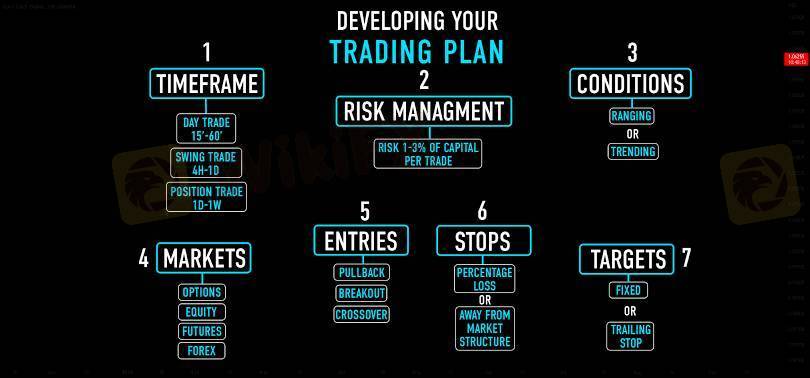
2025-01-30 18:25
الصناعةHow to Create a Crypto Trading Plan
#firstdealofthenewyearFateema
Creating a solid crypto trading plan is essential for managing risk, staying disciplined, and maximizing profits. Here’s a step-by-step guide to crafting an effective trading plan:
1. Define Your Trading Goals
Are you trading for short-term gains, long-term investment, or passive income?
Set clear objectives like daily, weekly, or monthly profit targets.
2. Choose a Trading Strategy
Select a strategy based on your risk tolerance and market knowledge:
Day Trading: Short-term trades within the same day.
Swing Trading: Holding for days or weeks to catch market swings.
Scalping: Profiting from small price movements frequently.
Position Trading: Long-term holding based on fundamental analysis.
3. Risk Management Rules
Set Stop-Loss & Take-Profit Levels: Prevent emotional trading by automating exits.
Use the 1-2% Rule: Never risk more than 1-2% of your trading capital on a single trade.
Diversification: Avoid putting all funds into one asset.
4. Choose the Right Trading Platform & Tools
Use reliable exchanges (e.g., Binance, Kraken, Uniswap for DEX).
Utilize charting tools (e.g., TradingView, CoinMarketCap, Dune Analytics).
Leverage portfolio tracking tools (e.g., CoinGecko, Zerion).
5. Conduct Market Analysis
Technical Analysis (TA): Study charts, trends, indicators (RSI, MACD, Bollinger Bands).
Fundamental Analysis (FA): Evaluate project whitepapers, team, partnerships, and tokenomics.
Sentiment Analysis: Monitor social media, news, and community discussions.
6. Maintain a Trading Journal
Record entry/exit points, strategy used, and results.
Analyze past trades to refine your approach.
7. Stay Updated & Adjust Your Plan
Follow market trends and adapt to new opportunities.
Adjust risk management based on market volatility.
8. Control Emotions & Stick to the Plan
Avoid FOMO (Fear of Missing Out) and panic selling.
Stay patient and disciplined—consistent strategy execution leads to success.
Would you like a template for tracking trades, or do you need help with a specific strategy?
إعجاب 0
Aniema30
المتداول
مناقشة حية
الصناعة
NFP updates URDU
الصناعة
دوج كوين
الصناعة
دوجكوين
الصناعة
صعود الذهب
الصناعة
لقاحات كورونا
الصناعة
السيارات
فئة المنتدى

منصة

المعرض

الوكيل

التوظيف

استيراتيجية التداول التلقائي

الصناعة

السوق

المؤشر
How to Create a Crypto Trading Plan
 نيجيريا | 2025-01-30 18:25
نيجيريا | 2025-01-30 18:25#firstdealofthenewyearFateema
Creating a solid crypto trading plan is essential for managing risk, staying disciplined, and maximizing profits. Here’s a step-by-step guide to crafting an effective trading plan:
1. Define Your Trading Goals
Are you trading for short-term gains, long-term investment, or passive income?
Set clear objectives like daily, weekly, or monthly profit targets.
2. Choose a Trading Strategy
Select a strategy based on your risk tolerance and market knowledge:
Day Trading: Short-term trades within the same day.
Swing Trading: Holding for days or weeks to catch market swings.
Scalping: Profiting from small price movements frequently.
Position Trading: Long-term holding based on fundamental analysis.
3. Risk Management Rules
Set Stop-Loss & Take-Profit Levels: Prevent emotional trading by automating exits.
Use the 1-2% Rule: Never risk more than 1-2% of your trading capital on a single trade.
Diversification: Avoid putting all funds into one asset.
4. Choose the Right Trading Platform & Tools
Use reliable exchanges (e.g., Binance, Kraken, Uniswap for DEX).
Utilize charting tools (e.g., TradingView, CoinMarketCap, Dune Analytics).
Leverage portfolio tracking tools (e.g., CoinGecko, Zerion).
5. Conduct Market Analysis
Technical Analysis (TA): Study charts, trends, indicators (RSI, MACD, Bollinger Bands).
Fundamental Analysis (FA): Evaluate project whitepapers, team, partnerships, and tokenomics.
Sentiment Analysis: Monitor social media, news, and community discussions.
6. Maintain a Trading Journal
Record entry/exit points, strategy used, and results.
Analyze past trades to refine your approach.
7. Stay Updated & Adjust Your Plan
Follow market trends and adapt to new opportunities.
Adjust risk management based on market volatility.
8. Control Emotions & Stick to the Plan
Avoid FOMO (Fear of Missing Out) and panic selling.
Stay patient and disciplined—consistent strategy execution leads to success.
Would you like a template for tracking trades, or do you need help with a specific strategy?
إعجاب 0
أريد أن اترك تعليق
تقديم
0تعليقات

لا توجد تعليقات حتى الآن ، كن أول شخص يعلق

تقديم
لا توجد تعليقات حتى الآن ، كن أول شخص يعلق